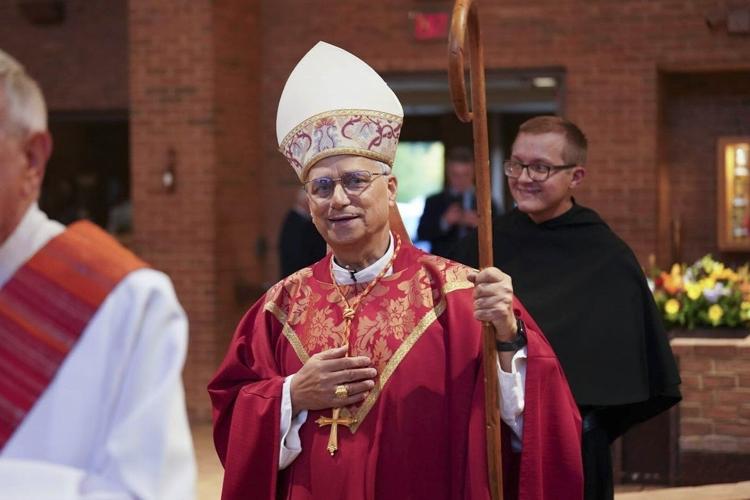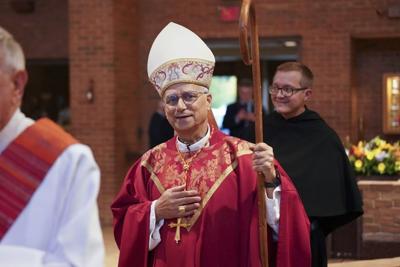NEW ORLEANS (AP) ŌĆö The new popeŌĆÖs French-sounding last name, Prevost, intrigued Jari Honora, a New Orleans genealogist, who began digging in the archives and discovered the pope had deep roots in the Big Easy.
All four of maternal great-grandparents were ŌĆ£free people of colorŌĆØ in Louisiana based on 19th-century census records, Honora found. As part of the melting pot of French, Spanish, African and Native American cultures in Louisiana, the popeŌĆÖs maternal ancestors would be considered Creole.
ŌĆ£It was special for me because I share that heritage and so do many of my friends who are Catholic here in New Orleans,ŌĆØ said Honora, a historian at the Historic New Orleans Collection, a museum in the French Quarter.
Honora and others in the Black and Creole Catholic communities say the election of Leo ŌĆö who spent over including eight years as a bishop ŌĆö is just what the Catholic Church needs to unify the global church and elevate the profile of .
A rich cultural identity
Leo, who has not spoken openly about his roots, may also have an ancestral connection to Haiti. His grandfather, Joseph Norval Martinez, may have been born there, though historical records are conflicting, Honora said. However, MartinezŌĆÖs parents ŌĆö the popeŌĆÖs great-grandparents ŌĆö were living in Louisiana since at least the 1850s, he said.
Andrew Jolivette, a professor of sociology and Afro-Indigenous Studies at the University of California, Santa Barbara, did his own digging and found the pope’s ancestry reflected the unique cultural tapestry of southern Louisiana. The pope’s Creole roots draw attention to the complex, nuanced identities Creoles hold, he said.
ŌĆ£There is Cuban ancestry on his maternal side. So, there are a number of firsts here and itŌĆÖs a matter of pride for Creoles,” said Jolivette, whose family is Creole from Louisiana. ŌĆ£So, I also view him as a Latino pope because the influence of Latino heritage cannot be ignored in the conversation about Creoles.ŌĆØ
Most Creoles are Catholic and historically it was their faith that kept families together as they migrated to larger cities like Chicago, Jolivette said.
The former Cardinal Robert Prevost’s maternal grandparents ŌĆö identified as ŌĆ£mulattoŌĆØ and ŌĆ£BlackŌĆØ in historical records ŌĆö were married in New Orleans in 1887 and lived in the cityŌĆÖs historically Creole Seventh Ward. In the coming years, the Jim Crow regime of racial segregation rolled back post-Civil War reforms and ŌĆ£just about every aspect of their lives was circumscribed by race, extending even to the church,ŌĆØ Honora said.
An American story of migration
The popeŌĆÖs grandparents migrated to Chicago around 1910, like many other African American families leaving the racial oppression of the Deep South, and ŌĆ£passed for white,ŌĆØ Honora said. The popeŌĆÖs mother, Mildred Agnes Martinez, who was born in Chicago, is identified as ŌĆ£whiteŌĆØ on her 1912 birth certificate, Honora said.
ŌĆ£You can understand, people may have intentionally sought to obfuscate their heritage,ŌĆØ he said. ŌĆ£Always life has been precarious for people of color in the South, New Orleans included.ŌĆØ
The popeŌĆÖs grandparentsŌĆÖ old home in New Orleans was later destroyed, along with hundreds of others, to build a highway overpass that ŌĆ£evisceratedŌĆØ a stretch of the largely Black neighborhood in the 1960s, Honora said.
A former New Orleans mayor, Marc Morial, called the pope’s family’s history, “an American story of how people escape American racism and American bigotry.ŌĆØ
As a Catholic with Creole heritage who grew up near the neighborhood where the popeŌĆÖs grandparents lived, Morial said he has contradictory feelings. While heŌĆÖs proud of the popeŌĆÖs connection to his city, Morial said the new pontiffŌĆÖs maternal familyŌĆÖs shifting racial identity highlights ŌĆ£the idea that in America people had to escape their authenticity to be able to survive.ŌĆØ
African American influence on Catholicism
The Rev. Ajani Gibson, who heads the predominantly Black congregation at St. Peter Claver Church in New Orleans, said he sees the popeŌĆÖs roots as a reaffirmation of African American influence on Catholicism in his city.
ŌĆ£I think a lot of people take for granted that the things that people love most about New Orleans are both Black and Catholic,ŌĆØ said Gibson, referring to rich , New Orleans’ jazz tradition and brass band parades known as .
He hoped the popeŌĆÖs Creole heritage ŌĆö emerging from the cityŌĆÖs ŌĆ£cultural gumbo potŌĆØ ŌĆö signals an inclusive outlook for the Catholic Church.
ŌĆ£I want the continued elevation of the universal nature of the church ŌĆö that the church looks, feels, sounds like everybody,ŌĆØ Gibson said. ŌĆ£We all have a place and we come and bring who we are, completely and totally, as gifts to the church.ŌĆØ
Shannen Dee Williams, a history professor at the University of Dayton, said she hopes that Leo’s ŌĆ£genealogical roots and historic papacy will underscore that all roads in American Catholicism, in North, South and Central America, lead back to the churchŌĆÖs foundational roots in its mostly unacknowledged and unreconciled histories of Catholic colonialism, slavery and segregation.ŌĆØ
ŌĆ£There have always been two trans-Atlantic stories of American Catholicism; one that begins with Europeans and another one that begins with Africans and African-descended people, free and enslaved, living in Europe and Africa in the 16th century,ŌĆØ she said. ŌĆ£Just as Black history is American history, (Leo’s) story also reminds us that Black history is, and always has been, Catholic history, including in the United States.ŌĆØ
Hope for the future
Kim R. Harris, associate professor of African American Religious Thought and Practice at Loyola Marymount University in Los Angeles, said the pope’s genealogy got her thinking about the seven who have been recognized by the National Black Catholic Congress, but haven’t yet been canonized.
Harris highlighted Pierre Toussaint, a philanthropist born in Haiti as a slave who became a New York City entrepreneur and was declared ŌĆ£VenerableŌĆØ by Pope John Paul II in 1997.
ŌĆ£The excitement I have in this moment probably has to do with the hope that this pope’s election will help move this canonization process along,ŌĆØ Harris said.
While it’s not known how Leo identifies himself racially, his roots bring a sense of hope to African American Catholics, she said.
ŌĆ£When I think about a person who brings so much of the history of this country in his bones, I really hope it brings to light who we are as Americans, and who we are as people of the diaspora,ŌĆØ she said. “It brings a whole new perspective and widens the vision of who we all are.ŌĆØ
Reynold Verret, president of Xavier University of Louisiana in New Orleans, the only historically Black Catholic university, said he was ŌĆ£a little surprisedŌĆØ about the pope’s heritage.
ŌĆ£It’s a joyful connection,ŌĆØ he said. ŌĆ£It is an affirmation that the Catholic Church is truly universal and that (Black) Catholics remained faithful regardless of a church that was human and imperfect. It also shows us that the church transcends national borders.ŌĆØ
___
Bharath reported from Los Angeles.
___
Brook is a corps member for The Associated Press/Report for America Statehouse News Initiative. is a nonprofit national service program that places journalists in local newsrooms to report on undercovered issues.
___
Associated Press religion coverage receives support through the APŌĆÖs with The Conversation US, with funding from Lilly Endowment Inc. The AP is solely responsible for this content.




























